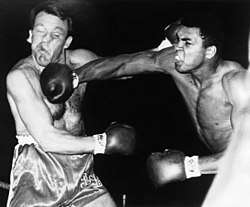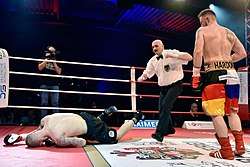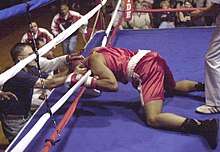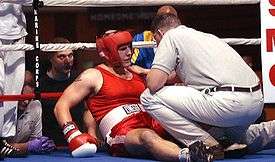Knockout
A knockout (abbreviated to KO or K.O.) is a fight-ending, winning criterion in several full-contact combat sports, such as boxing, kickboxing, muay thai, mixed martial arts, karate, some forms of taekwondo and other sports involving striking, as well as fighting-based video games. A full knockout is considered any legal strike or combination thereof that renders an opponent unable to continue fighting.

The term is often associated with a sudden traumatic loss of consciousness caused by a physical blow. Single powerful blows to the head (particularly the jawline and temple) can produce a cerebral concussion or a carotid sinus reflex with syncope and cause a sudden, dramatic KO. Body blows, particularly the liver punch, can cause progressive, debilitating pain that can also result in a KO.
In boxing and kickboxing, a knockout is usually awarded when one participant falls to the canvas and is unable to rise to their feet within a specified period of time, typically because of exhaustion, pain, disorientation, or unconsciousness. For example, if a boxer is knocked down and is unable to continue the fight within a ten-second count, they are counted as having been knocked out and their opponent is awarded the KO victory.
In mixed martial arts (MMA) competitions, no time count is given after a knockdown, as the sport allows submission grappling as well as ground and pound. If a fighter loses consciousness ("goes limp") as a result of legal strikes it is declared a KO.[1] Even if the fighter loses consciousness for a brief moment and wakes up again to continue to fight, the fight is stopped and declared a KO.[2] As many MMA fights can take place on the mat rather than standing, it is possible to score a KO via ground and pound, a common victory for grapplers.
In fighting-based video games, such as Street Fighter and Tekken, a player scores a knockout by fully depleting the opponent's health bar, which awards the round to the winning player. The player who wins the most rounds (by scoring the most knockouts or by having more vitality remaining when time expires during each round) wins the match. This is different from real-life combat sports, where a knockout would end the match immediately.
Technical knockout

A technical knockout (TKO or T.K.O.), or stoppage, is declared when the referee decides during a round that a fighter cannot safely continue the match for any reason. Certain sanctioning bodies also allow the official attending physician at ringside to stop the fight as well. In many regions, a TKO is declared when a fighter is knocked down three times in one round.[3]
In MMA bouts, the referee may declare a TKO if a fighter cannot intelligently defend him/herself while being repeatedly struck.[1]
Double knockout
A double knockout, in both real-life combat sports and fighting-based video games, is when both fighters trade blows and knock each other out simultaneously, and are both unable to continue fighting. In such cases, the match is declared a draw. In fighting games such as Street Fighter and Tekken, a draw is counted as a loss for both players.
Physical characteristics

Little is known about what exactly causes one to be knocked unconscious, but many agree it is related to trauma to the brain stem. This usually happens when the head rotates sharply, often as a result of a strike. There are three general manifestations of such trauma:
- a typical knockout, which results in a sustained (three seconds or more) loss of consciousness (comparable to general anesthesia, when the recipient emerges and has lost memory of the event).
- a "flash" knockout, when a very transient (less than three seconds) loss of consciousness occurs (in the context of a knock-down), and the recipient often maintains awareness and memory of the combat.
- a "stunning", a "dazing" or a fighter being "KO'ed on his feet", is when basic consciousness is maintained (and the fighter never leaves his feet) despite a general loss of awareness and extreme distortions in proprioception, balance, visual fields, and auditory processing. Referees are taught specifically to watch for this state, as it cannot be improved by sheer willpower and usually means the fighter is already concussed and unable to safely defend themselves.
A basic principle of boxing and other combat sports is to defend against this vulnerability by keeping both hands raised about the face and the chin tucked in. That could still be ineffective if the opponent punches effectively to the solar plexus.
A fighter who becomes unconscious from a strike with sufficient knockout power is referred to as having been knocked out or KO'd (kay-ohd). Losing balance without losing consciousness is referred to as being knocked down ("down but not out"). Repeated blows to the head, regardless whether they cause loss of consciousness, are known to gradually cause permanent brain damage. In severe cases this may cause strokes or paralysis.[4] This loss of consciousness is commonly known as becoming "punch drunk" or "shot". Because of this, many physicians advise against sports involving knockouts.[5]
Knockdown

A knockdown occurs when a fighter touches the floor of the ring with any part of the body other than the feet following a hit, but is able to rise back up and continue fighting. The term is also used if the fighter is hanging on to the ropes, caught between the ropes, or is hanging over the ropes and is unable to fall to the floor and cannot protect himself. A knockdown triggers a count by the referee (normally to 10); if the fighter fails the count, then the fight is ended as a KO.[6]
A flash knockdown is a knockdown where the fighter hits the canvas but recovers quickly enough that a count is not started.[6]
Knockout records
Top 10 boxers by most KOs
- Billy Bird (138)[7]
- Archie Moore (132)
- Young Stribling (129)
- Sam Langford (128)
- Buck Smith (120)
- Kid Azteca (114)
- George Odwell (111)[8]
- Sugar Ray Robinson, Alabama Kid (108)[9]
- Peter Maher (107)
- Sandy Saddler (103)
Top 10 boxing champions (including interims) by KO percentage
Inactive National Boxing Association, World Colored Boxing Championship as well as list on List of current world boxing champions and European Boxing Union.
- Edwin Valero, Artur Beterbiev (100%)
- Deontay Wilder, Gervonta Davis, Ángel Acosta (95%)
- Jonathan Guzmán (92%)
- Carlos Zárate Serna, Dmitry Kudryashov, Yuniel Dorticos, LaMar Clark (90%)
- Anthony Joshua, Rocky Marciano, Wilfredo Gomez, Aaron Pryor, Laila Ali, Gary Mason (88%)
- Vitali Klitschko, Gennady Golovkin, Errol Spence Jr., Naoya Inoue, Jaime Munguia (87%)
- Khaosai Galaxy (86%)
- Eduard Troyanovsky, Oleksandr Gvozdyk, Gerald McClellan, Miguel Berchelt, In-Chul Baek, David Benavidez (85%)
- Naseem Hamed, Alfonso Zamora, Frank Bruno, David Haye, George Foreman, Alberto Machado (84%)
MMA fighters by most KOs (20 or more knockouts)
- Travis Fulton (115)
- Igor Vovchanchyn (41)
- Travis Wiuff (39)
- Joe Riggs (37)
- Gilbert Yvel (34)
- Alexander Shlemenko (32)
- Paul Daley (31)
- Mirko Filipovic (30)
- Melvin Manhoef (29)
- Wanderlei Silva (27)
- Gegard Mousasi (26)
- Dan Severn (24)
- Alistair Overeem, Maiquel Falcao (23)
- Anderson Silva (22)
- Melvin Guillard (21)
- Robbie Lawler, Ben Rothwell, Paul Buentello, Tim Sylvia, Mauricio Rua, Alexander Emelianenko, Quinton Jackson, Sergei Kharitonov (20)
Top 10 MMA (champions, challengers) fighters by KO percentage
Fighters from inactive Pride Fighting Championships and active UFC/Bellator plus champions and former champions from other organizations.
- Ricco Rodriguez (100.00%)
- Melvin Manhoef (93.33%)
- Derrick Lewis (88.89%)
- Jimi Manuwa (88.23%)
- Mark Hunt (87.50%)
- Conor McGregor (81%)
- Cristiane Justino (76.43%)
- Cain Velasquez (73.33%)
- Yann Decoopman (72%)
- Thiago Santos, Junior Dos Santos (71%)
Most consecutive KOs
- Boxing: LaMar Clark (44)[10]
Note: Considering Clark's unbeaten run of 44–0 with 44 knockouts, one should take into account he faced limited to no opposition; his first bout with a top-ten ranked opponent, who happened to be Bartolo Soni (12–2–1), ended with a TKO loss for him. Two other notable cases of highly questionable consecutive knockout records in boxing history were Peter McNeeley running 36–1 with 30 knockouts before facing recently paroled Mike Tyson (41–1–0), and Richie Melito, who built up a record of 18–0 with 17 knockouts, and was dubbed the "White Tyson", before Bert Cooper (34–17) stopped him.[11] Less notable but nevertheless mentionable cases include Don Steele running 41–0 with 38 KOs before facing-off Brian Nielsen (38–0), and Faruq Saleem running 38–0 with 32 KOs before he faced casual actor Shawn McLean (3–4–0).
- MMA: Travis Fulton (10)
Most 1st round KOs and most consecutive 1st round KOs
- Boxing: Peter Maher (50)
- Consecutive/Boxing: Ali Raymi (21)
- MMA: Travis Fulton (68)
- Consecutive/MMA: Igor Vovchanchyn, Travis Fulton (7)
Top 10 K-1 and K-2 kickboxers by most KOs
- Changpuek Kiatsongrit (178)
- Andy Souwer (98)
- Badr Hari (92)
- Mike Zambidis (86)
- Branko Cikatic (82)
- Manson Gibson (80)
- Peter Aerts (79)
- Rob Kaman (77)
- Buakaw Banchamek, Tyrone Spong (73)
- Jerome Le Banner (70)
Boxing's 50 knockout club (professional boxers with 50 or more knockouts)
- Billy Bird 138
- Archie Moore 131
- Young Stribling 126
- Sam Langford 126
- Buck Smith 120
- Kid Azteca 114
- George Odwell 111
- Sugar Ray Robinson 108
- Alabama Kid 108
- Peter Maher (boxer) 107
- Sandy Saddler 103
- Henry Armstrong 101
- Joe Gans 100
- Jimmy Wilde 98
- Jorge Castro (boxer) 90
- Tiger Jack Fox 89
- Jock McAvoy 88
- Julio César Chávez 86
- Yori Boy Campas 83
- Chalky Wright 83
- Tommy Freeman 83
- Jose Luis Ramirez 82
- Charles Ledoux 81
- Ted Kid Lewis 80
- Fritzie Zivic 80
- Rubén Olivares 79
- George Godfrey 77
- George Chaney 76
- Torpedo Billy Murphy 76
- Ceferino Garcia 74
- Primo Carnera 72
- Benny Bass 72
- Rodolfo Gonzalez (boxer) 71
- Tommy Ryan 71
- Roberto Durán 70
- Benny Leonard 70
- Jesus Pimentel 68
- Fred Fulton 68
- Earnie Shavers 68
- George Foreman 68
- Joe Jeanette 68
- Bill Brennan (boxer) 68
- Lou Brouillard 67
- Tommy Gomez 67
- Pedro Carrasco 66
- Billy Petrolle 66
- Marcel Cerdan 66
- Jack Dillon 66
- Lee Savold 65
- Willie Pep 65
- Elmer Ray 64
- George Chuvalo 63
- Carlos Zárate Serna 63
- Frank Moody 63
- Eduardo Lausse 62
- Alexis Arguello 62
- Jack Kid Berg 61
- Barbados Joe Walcott 61
- Larry Gains 61
- Adilson Rodrigues 61
- Mickey Walker (boxer) 60
- Freddie Steele 60
- Ike Williams 60
- Cleveland Williams 60
- Gregorio Peralta 60
- Tami Mauriello 60
- Max Baer (boxer) 59
- Young Peter Jackson 59
- Carlos Monzon 59
- Joe Knight (boxer) 59
- Ricardo Moreno 59
- Panama Al Brown 59
- Kid Pascualito 59[12]
- James Red Herring 58
- Eric Esch 58
- Tony Galento 57
- John Henry Lewis 57
- Pascual Perez (boxer) 57
- Charley White 57
- Kid Williams 57
- Len Harvey 57
- Jose Luis Castillo 57
- Bob Fitzsimmons 57
- Tiger Flowers 56
- Georges Carpentier 56
- Pedro Montanez 56
- Irish Bob Murphy 56
- Charles Kid McCoy 55
- Dixie Kid 55
- Gorilla Jones 55
- Freddie Mills 55
- Manuel Ortiz (boxer) 54
- Marcel Thil 54
- Solly Krieger 54
- Jose Napoles 54
- Bennie Briscoe 53
- Obie Walker 53
- Peter Kane 53
- Wladimir Klitschko 53
- Shannon Briggs 53
- Eugene Criqui 53
- Joe Louis 52
- Mike McTigue 52
- Philadelphia Jack O'Brien 52
- Lew Jenkins 52
- Marvin Hagler 52
- Rocky Graziano 52
- Ezzard Charles 52
- Arturo Godoy 51
- Kid Chocolate 51
- Packey McFarland 51
- Jimmy Slattery 51
- Abe Attell 51
- Miguel Angel Castellini 51
- Jorge Vaca 51
- Jorge Paez 51
- Marco Antonio Rubio 51
- Charley Burley 50
- Jose Legra 50
- Eder Jofre 50
See also
References
- "Rules and Regulations - Unified Rules and Other MMA Regulations". www.ufc.com. Archived from the original on 2016-04-16.
- http://mixedmartialarts.com/mma-news/341856/Herb-Dean-The-fight-is-over-when-hes-unconscious%5B%5D
- Sugar, Bert. Boxing Archived 2006-06-19 at the Wayback Machine. www.owingsmillsboxingclub.com. URL last accessed March 4, 2006.
- "Boxer gets record $22 million settlement from New York in brain injury case". mmafighting.com. Archived from the original on 2017-09-18.
- Lieberman, Abraham (1 April 2005), Causing Parkinson: Boxing, Brain Injury, archived from the original on 15 May 2006, retrieved 24 June 2010
- Boxing Terminology Archived 2012-06-25 at the Wayback Machine Ringside by Gus. URL last accessed June 17, 2008.
- "Billy Bird". Archived from the original on 2014-10-18. Retrieved 2013-01-30.
- "George Odwell". Archived from the original on 2014-10-18. Retrieved 2013-01-30.
- "Alabama Kid". Archived from the original on 2014-10-18. Retrieved 2013-01-30.
- "Boxing by the numbers". Archived from the original on 2012-12-15.
- Newfield, Jack (November 12, 2001). "The Shame of Boxing: The fighters are powerless workers in need of rights and justice". The Nation. 273 (17): 20. ISSN 0027-8378.
- https://boxrec.com/en/proboxer/9496
External links
- KO statistics of Mike Tyson, Wladimir Klitschko, Earnie Shavers, George Foreman and other heavyweight boxers
- All famous MMA knockouts
- The differences between knockouts and concussions; a simple discussion for beginning boxers
- https://archive.today/20130505222319/http://www.cyberboxingzone.com/cbzforum/showthread.php?1450-Most-Knockouts-Career